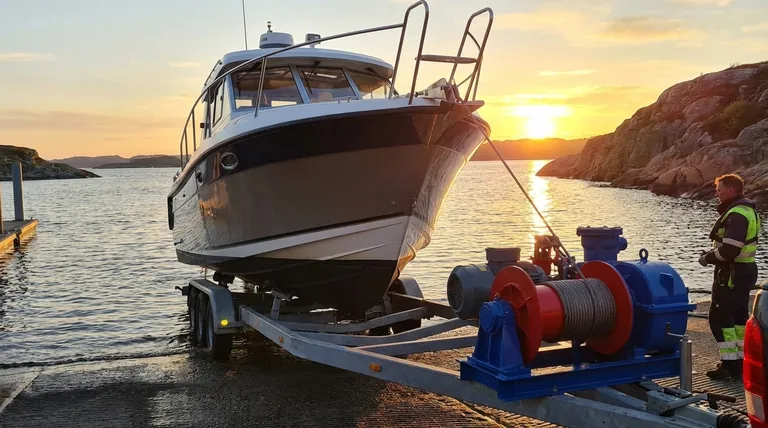At its core, a boat winch is a mechanical device that gives you a powerful pulling advantage. It is most commonly used to haul a boat out of the water and onto its trailer. A winch uses a crank or motor to wind a strap or cable around a drum, attached to your boat's bow, making the process of loading your boat far easier and safer.
A "boat winch" is not a single tool but a category of devices designed for heavy pulling. Its specific job depends on its type—most often either a trailer winch for loading the boat or an anchor winch for retrieving the anchor.

The Two Primary Types of Boat Winches
While both types use the same basic principle of mechanical pulling, their application on a boat is entirely distinct. Understanding which one you're dealing with is the first step.
The Trailer Winch: Loading and Unloading
This is the most common type of boat winch. Its sole purpose is to pull your boat from the water onto its trailer bunks.
By attaching the winch line to the bow eye of your boat and cranking the handle (or activating the motor), you can single-handedly guide the vessel into place, saving significant physical effort.
This controlled pull also prevents damage to the boat's hull that can occur from mishandling during manual loading, extending the life of your boat.
The Anchor Winch: Effortless Anchoring
An anchor winch, or windlass, is mounted on the bow of the boat itself and is designed to raise and lower the anchor.
This completely eliminates the strenuous and often hazardous task of manually hauling up a heavy anchor and its chain or rope.
Using an anchor winch improves safety by preventing back injuries, which are common with manual anchor handling, and saves considerable time and strain.
How a Winch Works: The Core Mechanics
Whether manual or powered, all winches operate on a similar principle of using gears to multiply force.
The Manual Winch
A manual winch uses a hand-cranked mechanism to turn a set of gears.
This gearbox increases the force you apply to the crank, allowing you to pull a load far heavier than you could manage on your own. A ratchet lock prevents the drum from unwinding and the boat from slipping back.
The Powered Winch (Electric & Hydraulic)
Powered winches replace the hand crank with a motor, most commonly an electric one connected to the boat's or tow vehicle's battery.
For much larger vessels and heavier loads, a hydraulic winch uses pressurized fluid to drive a motor, generating immense mechanical force for the most demanding pulling tasks.
Understanding the Trade-offs
Choosing or using a winch requires acknowledging its limitations and the differences between types.
Manual vs. Powered
A manual winch is simple, highly reliable, and less expensive. Its main drawback is the physical effort required, which can be significant for larger boats.
A powered winch offers effortless operation at the push of a button. However, it is more expensive, requires a power source, and adds complexity with more components that could potentially fail.
Capacity is Non-Negotiable
A winch's capacity—the maximum weight it can safely pull—is its most important specification.
Using an undersized winch is dangerous, as it can lead to gear failure or a snapped line, causing the boat to roll backward uncontrollably. Always ensure your winch's capacity is rated well above the combined weight of your boat, engine, and gear.
Making the Right Choice for Your Goal
Matching the winch to your specific task is essential for safety and efficiency.
- If your primary focus is launching and retrieving your boat: A properly rated trailer winch is a non-negotiable piece of equipment.
- If your primary focus is to make anchoring easier and safer: An anchor winch (windlass) is a worthwhile upgrade that transforms the experience.
- If your primary focus is on maximum power for a large vessel: A hydraulic winch provides the robust, heavy-duty performance required.
Ultimately, understanding the specific role of your winch ensures a safer, more efficient, and more enjoyable time on the water.
Summary Table:
| Winch Type | Primary Function | Key Benefit |
|---|---|---|
| Trailer Winch | Load/unload boat onto trailer | Saves physical effort, prevents hull damage |
| Anchor Winch | Raise/lower the anchor | Eliminates manual hauling, improves safety |
Ready to upgrade your boat handling? Whether you're a construction company managing marine equipment or a contractor needing reliable pulling power, GARLWAY specializes in durable, high-capacity winches built for demanding environments. Our expertise in construction machinery ensures you get a winch that delivers safety and performance. Contact GARLWAY today for a solution tailored to your needs!
Visual Guide

Related Products
- Electric 120V Boat Winch by Badlands
- Electric Hoist Winch Boat Anchor Windlass for Marine Applications
- Heavy Duty Electric Boat Winch Windlass Anchor
- Warn Winch Windlass Boat Trailer Winch
- Ready Mixer Machine for Construction Ready Mix Machinery
People Also Ask
- How much current does an electric boat winch draw? Plan Your Electrical System for Peak Performance
- What are marine electric winches and their characteristics? Key Features for Reliable Maritime Operations
- How does the boat launch ramp condition affect winch selection? Ensure Safe Retrieval on Any Ramp
- How do electric boat winches work? Unlock Effortless Launching & Retrieval
- How to pick a boat winch? Choose the Right Trailer or Anchor Winch for Your Boat















